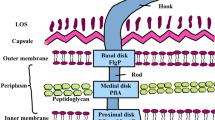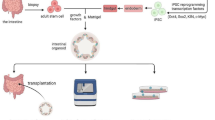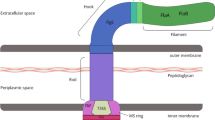Abstract
Among the major enteric pathogens, Campylobacter jejuni is considered an important source of diarrheal illness in humans. In contrast to the acute gastroenteritis in humans, C. jejuni exhibits prolonged cecal colonization at a high level with little or no pathology in chickens. Although several known virulence determinants of C. jejuni have been found to be associated with a higher degree of pathogenesis in humans, to date, little is known about their functions in the persistent colonization of chickens. The present study was undertaken to assess the role of C. jejuni in imparting differential host immune responses in human and chicken cells. Based on the abundance of major genes encoding virulence factors (GEVFs), we used a particular isolate that harbors the cadF, flaA, peb1, racR, ciaB, cdtB, and hcp genes. This study showed that hypervirulent C. jejuni isolate that encodes a functional type VI secretion system (T6SS) has a greater ability to invade and create characteristic “attaching and effacing” lesions in human INT407 compared to primary chicken embryo intestinal cells (CEICs). Furthermore, we demonstrated that the higher bacterial invasion in human INT407 triggered higher levels of expression of major proinflammatory cytokines, such as IL- 1β and IL-6, and significant downregulation of IL-17A gene expression (P ≤ 0.05). The findings of the present study suggest that the enhanced ability of C. jejuni to invade human cells is tightly regulated by proinflammatory cytokines in the gut and possibly holds the keys to the observed differences in pathogenesis between human and chicken cells.
Similar content being viewed by others
References
Acheson, D.W.K. 2009. Food and waterborne illnesses, pp. 365–381. In Schaechter, M. (ed.), Encyclopedia of microbiology (3rd ed.), Academic Press, Oxford, UK.
Ailes, E., Demma, L., Hurd, S., Hatch, J., Jones, T.F., Vugia, D., Cronquist, A., Tobin-D’Angelo, M., Larson, K., Laine, E., et al. 2008. Continued decline in the incidence of Campylobacter infections, Food Net 1996–2006. Foodborne Pathog. Dis. 5, 329–337.
Alemka, A., Corcionivoschi, N., and Bourke, B. 2012. Defense and adaptation: the complex inter-relationship between Campylobacter jejuni and mucus. Front. Cell Infect. Microbiol. 2, 15.
Allos, B.M. 2001. Campylobacter jejuni infections: update on emerging issues and trends. Clin. Infect. Dis. 32, 1201–1206.
Altekruse, S.F., Stern, N.J., Fields, P.I., and Swerdlow, D.L. 1999. Campylobacter jejuni-an emerging foodborne pathogen. Emerg. Infect. Dis. 5, 28–35.
Beery, J.T., Hugdahl, M.B., and Doyle, M.P. 1988. Colonization of gastrointestinal tracts of chicks by Campylobacter jejuni. Appl. Environ. Microbiol. 54, 2365–2370.
Biswas, D., Hannon, S.J., Townsend, H.G., Potter, A., and Allan, B.J. 2011. Genes coding for virulence determinants of Campylobacter jejuni in human clinical and cattle isolates from Alberta, Canada, and their potential role in colonization of poultry. Int. Microbiol. 14, 25–32.
Bleumink-Pluym, N.M., van Alphen, L.B., Bouwman, L.I., Wösten, M.M., and van Putten, J.P. 2013. Identification of a functional type VI secretion system in Campylobacter jejuni conferring capsule polysaccharide sensitive cytotoxicity. PLoS Pathog. 9, e1003393.
Brown, H.L., Hanman, K., Reuter, M., Betts, R.P., and van Vliet, A.H. 2015. Campylobacter jejuni biofilms contain extracellular DNA and are sensitive to DNase I treatment. Front. Microbiol. 6, 699.
Burnett, T.A., Hornitzky, M.A., Kuhnert, P., and Djordjevic, S.P. 2002. Speciating Campylobacter jejuni and Campylobacter coli isolates from poultry and humans using six PCR-based assays. FEMS Microbiol. Lett. 216, 201–209.
Byrne, C.M., Clyne, M., and Bourke, B. 2007. Campylobacter jejuni adhere to and invade chicken intestinal epithelial cells in vitro. Microbiology 153, 561–569.
Casabonne, C., Gonzalez, A., Aquili, V., Subils, T., and Balague, C. 2016. Prevalence of seven virulence genes of Campylobacter jejuni isolated from patients with diarrhea in Rosario, Argentina. Int. J. Infect. 3, e37727.
Cean, A., Corcionivoschi, N., Stef, L., Dumitrescu, G., Sărăndan, M., Ghise, A., Julean, C., and Drinceanu, D. 2013. Isolation of Campylobacter jejuni from cloaca and cecum content of chicken broilers bred in intensive systems in the western part of Romani. Anim. Sci. Biotechnol. 46, 93–97.
Corcionivoschi, N., Gundogdu, O., Moran, L., Kelly, C., Scates, P., Stef, L., Cean, A., Wren, B., Dorrell, N., and Madden, R.H. 2015. Virulence characteristics of hcp+ Campylobacter jejuni and Campylobacter coli isolates from retail chicken. Gut Pathog. 7, 20.
Dasti, J.I., Tareen, A.M., Lugert, R., Zautner, A.E., and Gross, U. 2010. Campylobacter jejuni: A brief overview on pathogenicity-associated factors and disease-mediating mechanism. Int. J. Med. Microbiol. 300, 205–211.
Datta, S., Niwa, H., and Itoh, K. 2003. Prevalence of 11 pathogenic genes of Campylobacter jejuni by PCR in strains isolated from humans, poultry meat and broiler and bovine faeces. J. Med. Microbiol. 52, 345–348.
Edwards, L.A., Nistala, K., Mills, D.C., Stephenson, H.N., Zilbauer, M., Wren, B.W., Dorrell, N., Lindley, K.J., Wedderburn, L.R., and Bajaj-Elliott, M. 2010. Delineation of the innate and adaptive T-cell immune outcome in the human host in response to Campylobacter jejuni infection. PLoS One 5, e15398.
Eskan, M.A., Benakanakere, M.R., Rose, B.G., Zhang, P., Zhao, J., Stathopoulou, P., Fujioka, D., and Kinane, D.F. 2008. Interleukin-1β Modulates proinflammatory cytokine production in human epithelial cells. Infect. Immun. 76, 2080–2089.
Fabrega, M.J., Aguilera, L., Gimenez, R., Varela, E., Alexandra Canas, M., Antolin, M., Badia, J., and Baldoma, L. 2016. Activation of immune and defense responses in the intestinal mucosa by outer membrane vesicles of commensal and probiotic Escherichia coli strains. Front. Microbiol. 7, 705.
Friis, L.M., Keelan, M., and Taylor, D.E. 2009. Campylobacter jejuni drives MyD88-independent interleukin-6 secretion via toll-like receptor 2. Infect. Immun. 77, 1553–1560.
Fujino, S., Andoh, A., Bamba, S., Ogawa, A., Hata, K., Araki, Y., Bamba, T., and Fujiyama, Y. 2003. Increased expression of interleukin 17 in inflammatory bowel disease. Gut 52, 65–70.
Ge, Z., Schauer, D.B., and Fox, J.G. 2008. In vivo virulence properties of bacterial cytolethal-distending toxin. Cell Microbiol. 10, 1599–1607.
Grimaldi, E., Donnarumma, G., Perfetto, B., De Filippis, A., Melito, A., and Tufano Maria, A. 2009. Proinflammatory signal transduction pathway induced by Shigella flexneri porins in caco-2 cells. Braz. J. Microbiol. 40, 701–709.
Hanel, I., Borrmann, E., Muller, J., and Alter, T. 2007. Relationships between bacterial genotypes and in vitro virulence properties of Campylobacter jejuni and Campylobacter coli isolated from turkeys. J. Appl. Microbiol. 102, 433–441.
Hannu, T., Mattila, L., Rautelin, H., Pelkonen, P., Lahdenne, P., Siitonen, A., and Leirisalo-Repo, M. 2002. Campylobacter-triggered reactive arthritis: a population-based study. Rheumatology 41, 312–318.
Harrison, J.W., Dung T.T., Siddiqui, F., Korbrisate, S., Bukhari, H., Tra, M.P., Hoang, N.N., Carrique-Mas, J., Bryant, J., Campbell, J.I., et al. 2014. Identification of possible virulence marker from Campylobacter jejuni isolates. Emerg. Infect. Dis. 20, 1029.
Hébert, G.A., Hollis, D.G., Weaver, R.E., Lambert, M.A., Blaser, M.J., and Moss, C.W. 1982. 30 years of campylobacters: biochemical characteristics and a biotyping proposal for Campylobacter jejuni. J. Clin. Microbiol. 15, 1065–1073.
Hermans, D., Pasmans, F., Messens, W., Martel, A., Van Immerseel, F., Rasschaert, G., Heyndrickx, M., Van Deun, K., and Haesebrouck, F. 2012. Poultry as a host for the zoonotic pathogen Campylobacter jejuni. Vector Borne Zoonotic Dis. 12, 89–98.
Hermans, D., Van Deun, K., Martel, A., Van Immerseel, F., Messens, W., Heyndrickx, M., Haesebrouck, F., and Pasmans, F. 2011. Colonization factors of Campylobacter jejuni in the chicken gut. Vet. Res. 42, 82.
Hilbert, F., Scherwitzel, M., Paulsen, P., and Szostak, M.P. 2010. Survival of Campylobacter jejuni under conditions of atmospheric oxygen tension with the support of Pseudomonas spp. Appl. Environ. Microbiol. 76, 5911–5917.
Hong, Y.H., Lillehoj, H.S., Lee, S.H., Dalloul, R.A., and Lillehoj, E.P. 2006. Analysis of chicken cytokine and chemokine gene expression following Eimeria acervulina and Eimeria tenella infections. Vet. Immunol. Immunopathol. 114, 209–223.
Humphrey, S., Chaloner, G., Kemmett, K., Davidson, N., Williams, N., Kipar, A., Humphrey, T., and Wigley, P. 2014. Campylobacter jejuni is not merely a commensal in commercial broiler chickens and affects bird welfare. MBio 5, e01364-14.
Ishihara, K. and Hirano, T. 2002. IL-6 in autoimmune disease and chronic inflammatory proliferative disease. Cytokine Growth Factor Rev. 13, 357–368.
Jani, A.J. and Cotter, P.A. 2010. Type VI secretion: not just for pathogenesis anymore. Cell Host Microbe 8, 2–6.
John, D.A., Williams, L.K., Kanamarlapudi, V., Humphrey, T.J., and Wilkinson, T.S. 2017. The bacterial species Campylobacter jejuni induce diverse innate immune responses in human and avian intestinal epithelial cells. Front. Microbiol. 29, 1840.
Kaakoush, N.O., Castano-Rodriguez, N., Mitchell, H.M., and Man, S.M. 2015. Global epidemiology of Campylobacter infection. Clin. Microbiol. Rev. 28, 687–720.
Kalmokoff, M., Lanthier, P., Tremblay, T.L., Foss, M., Lau, P.C., Sanders, G., Austin, J., Kelly, J., and Szymanski, C.M. 2006. Proteomic analysis of Campylobacter jejuni 11168 biofilms reveals a role for the motility complex in biofilm formation. J. Bacteriol. 188, 4312–4320.
Kim, J.S., Park, C., and Kim, Y.J. 2015. Role of flgA for flagellar biosynthesis and biofilm formation of Campylobacter jejuni NCTC-11168. J. Microbiol. Biotechnol. 25, 1871–1879.
Konkel, M.E., Klena, J.D., Rivera-Amill, V., Monteville, M.R., Biswas, D., Raphael, B., and Mickelson, J. 2004. Secretion of virulence proteins from Campylobacter jejuni is dependent on a functional flagellar export apparatus. J. Bacteriol. 186, 3296–3303.
Lai, C.K., Chen, Y.A., Lin, C.J., Lin, H.J., Kao, M.C., Huang, M.Z., Lin, Y.H., Chiang-Ni, C., Chen, C.J., Lo, U.G., et al. 2016. Molecular mechanisms and potential clinical applications of Campylobacter jejuni cytolethal distending toxin. Front. Cell Infect. Microbiol. 6, 9.
Lertpiriyapong, K., Gamazon, E.R., Feng, Y., Park, D.S., Pang, J., Botka, G., Graffam, M.E., Ge, Z., and Fox, J.G. 2012. Campylobacter jejuni type VI secretion system roles in adaptation to deoxycholic acid, host cell adherence, invasion, and in vivo colonization. PLoS One 7, e42842.
Li, Y.P., Ingmer, H., Madsen, M., and Bang, D.D. 2008. Cytokine response in primary chicken embryo intestinal cells infected with Campylobacter jejuni strains of human and chicken origin. BMC Microbiol. 8, 107.
Lien, Y.W. and Lai, E.M. 2017. Type VI secretion effectors: Methodologies and biology. Front. Cell. Infect. Microbiol. 7, 254.
MacCallum, A., Haddock, G., and Everest, P.H. 2005. Campylobacter jejuni activates mitogen-activated protein kinases in Caco-2 cell monolayers and in vitro infected primary human colonic tissues. Microbiology 151, 2765–2772.
Meinersmann, R.J., Rigsby, W.E., Stern, N.J., Kelley, L.C., Hill, J.E., and Doyle, M.P. 1991. Comparative study of colonizing and noncolonizing Campylobacter jejuni. Am. J. Vet. Res. 52, 1518–1522.
Melo, R.T., Nalevaiko, P.C., Mendonça, E.P., Borges, L.W., Fonseca, B.B., Beletti, M.E., and Rossi, D.A. 2013. Campylobacter jejuni strains isolated from chicken meat harbour several virulence factors and represent a potential risk to humans. Food Control 33, 227–231.
Murdoch, S.L., Trunk, K., English, G., Fritsch, M.J., Pourkarimi, E., and Coulthurst, S.J. 2011. The opportunistic pathogen Serratia marcescens utilizes type VI secretion to target bacterial competitors. J. Bacteriol. 193, 6057–6069.
Newell, D.G. and Fearnley, C. 2003. Sources of Campylobacter colonization in broiler chickens. Appl. Environ. Microbiol. 69, 4343–4351.
Pukatzki, S., Ma, A.T., Sturtevant, D., Krastins, B., Sarracino, D., Nelson, W.C., Heidelberg, J.F., and Mekalanos, J.J. 2006. Identification of a conserved bacterial protein secretion system in Vibrio cholerae using the Dictyostelium host model system. Proc. Natl. Acad. Sci. USA 103, 1528–1533.
Quetz J.D.S., S., Lima, I.F., Havt, A., Prata, M.M., Cavalcante, P.A., Medeiros, P.H., Cid, D.A., Moraes, M.L., Rey, L.C., Soares, A.M., et al. 2012. A Campylobacter jejuni infection and virulence associated genes in children with moderate to severe diarrhoea admitted to emergency rooms in north-eastern Brazil. J. Med. Microbiol. 61, 507–513.
Reed, R.P., Friedland, I.R., Wegerhoff, F.O., and Khoosal, M. 1996. Campylobacter bacteremia in children. Pediatr. Infect. Dis. J. 15, 345–348.
Reuter, M., Mallett, A., Pearson, B.M., and van Vliet, A.H. 2010. Biofilm formation by Campylobacter jejuni is increased under aerobic conditions. Appl. Environ. Microbiol. 76, 2122–2128.
Ribet, D. and Cossart, P. 2015. How bacterial pathogens colonize their hosts and invade deeper tissues. Microbes Infect. 17, 173–183.
Richards, C.D. 1998. Interleukin-6, pp. 87–108. In Mire-Sluis, A.R. and Thorpe, R. (eds.), Cytokines. Academic Press, London, England.
IRizal, A., Kumar, A., and Vidyarthi, A.S. 2010. Prevalence of pathogenic genes in Campylobacter jejuni isolated from poultry and human. Int. J. Food Safety 12, 29–34.
Sahin, O., Morishita, T.Y., and Zhang, Q. 2002. Campylobacter colonization in poultry: sources of infection and modes of transmission. Anim. Health Res. Rev. 3, 95–105.
Schell, M.A., Ulrich, R.L., Ribot, W.J., Brueggemann, E.E., Hines, H.B., Chen, D., Lipscomb, L., Kim, H.S., Mrazek, J., Nierman, W.C., et al. 2007. Type VI secretion is a major virulence determinant in Burkholderia mallei. Mol. Microbiol. 64, 1466–1485.
Schwarz, S., West, T.E., Boyer, F., Chiang, W.C., Carl, M.A., Hood, R.D., Rohmer, L., Tolker-Nielsen, T., Skerrett, S.J., and Mougous, J.D. 2010. Burkholderia type VI secretion systems have distinct roles in eukaryotic and bacterial cell interactions. PLoS Pathog. 6, e1001068.
Sha, J., Rosenzweig, J.A., Kozlova, E.V., Wang, S., Erova, T.E., Kirtley, M.L., van Lier, C.J., and Chopra, A.K. 2013. Evaluation of the roles played by Hcp and VgrG type 6 secretion system effectors in Aeromonas hydrophila SSU pathogenesis. Microbiology 159, 1120–1135.
Silva, J., Leite, D., Fernandes, M., Mena, C., Gibbs, P.A., and Teixeira, P. 2011. Campylobacter spp. as a foodborne pathogen: A review. Front. Microbiol. 2, 200.
Smith, C.K., Kaiser, P., Rothwell, L., Humphrey, T., Barrow, P.A., and Jones, M.A. 2005. Campylobacter jejuni-induced cytokine responses in avian cells. Infect. Immun. 73, 2094–2100.
Stern, N.J. 1992. Reservoirs for Campylobacter jejuni and approaches for intervention in poultry, pp. 49–60. Campylobacter jejuni current status and future trends. American Society for Microbiology, Washington, D.C., USA.
Talukder, K.A., Aslam, M., Islam, Z., Azmi, I.J., Dutta, D.K., Hossain, S., Nur-E-Kamal, A., Nair, G.B., Cravioto, A., Sack, D.A., et al. 2008. Prevalence of virulence genes and cytolethal distending toxin production in Campylobacter jejuni isolates from diarrheal patients in Bangladesh. J. Clin. Microbiol. 46, 1485–1488.
Tauxe, R. 1992. Epidemiology of Campylobacter jejuni infections in the United States and other industrialized nations, pp. 9–19. In Nachamkin, I., Blaser, M., and Tompkins, L. (eds.), Campylobacter jejuni: current status and future trends. American Society for Microbiology, Washington, D.C., USA.
Tauxe, R.V. 1997. Emerging foodborne diseases: an evolving public health challenge. Emerg. Infect. Dis. 3, 425–434.
Taylor, D.E., Hiratsuka, K., and Mueller, L. 1989. Isolation and characterization of catalase-negative and catalase-weak strains of Campylobacter species, including “Campylobacter upsaliensis,” from humans with gastroenteritis. J. Clin. Microbiol. 27, 2042–2045.
Ugarte-Ruiz, M., Gómez-Barrero, S., Porrero, M.C., Alvarez, J., García, M., Comerón, M.C., Wassenaar, T.M., and Domínguez, L. 2012. Evaluation of four protocols for the detection and isolation of thermophilic Campylobacter from different matrices. J. Appl. Microbiol. 113, 200–208.
Vaezirad, M.M., Keestra-Gounder, A.M., de Zoete, M.R., Koene, M.G., Wagenaar, J.A., and van Putten, J.P.M. 2017. Invasive behaviour of Campylobacter jejuni in immunosuppressed chicken. Virulence 8, 248–260.
Vaishnavi, C., Singh, M., Thakur, J.S., and Thapa, B.R. 2015. Low prevalence of campylobacteriosis in the northern region of India. Adv. Microbiol. 5, 155–165.
Verhoeff-Bakkenes, L., Hazeleger, W.C., Zwietering, M.H., and De Jonge, R. 2008. Lack of response of INT-407 cells to the presence of non-culturable Campylobacter jejuni. Epidemiol. Infect. 136, 1401–1406.
Yamazaki-Matsune, W., Taguchi, M., Seto, K., Kawahara, R., Kawatsu, K., Kumeda, Y., Kitazato, M., Nukina, M., Misawa, N., and Tsukamoto, T. 2007. Development of a multiplex PCR assay for identification of Campylobacter coli, Campylobacter fetus, Campylobacter hyointestinalis subsp. hyointestinalis, Campylobacter jejuni, Campylobacter lari and Campylobacter upsaliensis. J. Med. Microbiol. 56, 1467–1473.
Yuki, N., Taki, T., Inagaki, F., Kasama, T., Takashai, M., Saitho, K., and Miyatake, T. 1993. A bacterium lipopolysaccharide that elicits Guillain-Barré syndrome has a GM1 ganglioside-like structure. J. Exp. Med. 178, 1771–1775.
Zheng, J., Meng, J., Zhao, S., Singh, R., and Song, W. 2008. Campylobacter-induced interleukin-8 secretion in polarized human intestinal epithelial cells requires Campylobacter-secreted cytolethal distending toxin-and Toll-like receptor-mediated activation of NF-κB. Infect. Immun. 76, 4498–4508.
Author information
Authors and Affiliations
Corresponding author
Additional information
Supplemental material for this article may be found at https://doi.org/www.springerlink.com/content/120956.
Electronic supplementary material
Rights and permissions
About this article
Cite this article
Singh, A., Mallick, A.I. Role of putative virulence traits of Campylobacter jejuni in regulating differential host immune responses. J Microbiol. 57, 298–309 (2019). https://doi.org/10.1007/s12275-019-8165-0
Received:
Revised:
Accepted:
Published:
Issue Date:
DOI: https://doi.org/10.1007/s12275-019-8165-0




